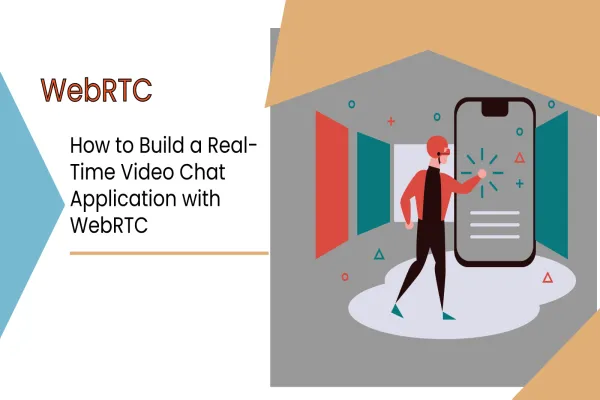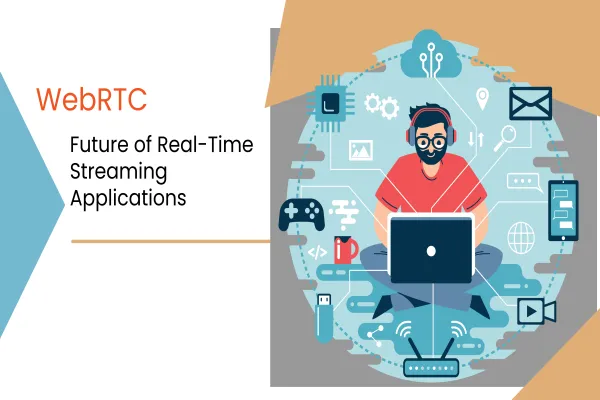WebRTC (Web Real-Time Communication) is the technology that empowers sites and applications with the ability of audio-visual media. The technology allows one to capture and optionally stream video and audio in real-time while exchanging arbitrary data between browsers without having a need for an intermediary.
WebRTC as Real-Time Streaming Solution: How business can use it
WebRTC is widely used to deliver the user experience. From Google Meets, Google Hangouts, and Facebook Messenger, to Discord, and Amazon Chime, WebRTC has found a place in some of the known massive applications. Businesses can deploy WebRTC for various functionalities such as-
- Remote content delivery
- Contact centres
- E-commerce
- Healthcare
- IoT
- Education
WebRTC delivers promising benefits like low latency delivery, easy collaboration, and secured multi-user audio-visual calls. WebRTC can be integrated into an organization’s website easily, and can also be embedded into mobile applications, company websites, or marketing banners published on the Internet as ads. The solution makes collaboration simpler, and also facilitates external parties to arrange web conferencing over the Internet without having a need for a separate application or plugin.
While WebRTC has emerged as an innovative, real-time streaming, and disruptive communication solution, this high-quality technology also needs prior testing to ensure unified communication or seamless P2P connections. But what exactly is WebRTC testing solution?
WebRTC Testing Made Easy
WebRTC testing is rather unique as challenges are multi-fold. Not only is the web-based application tested, but the system should also be able to test the voice and audio across the browsers. This makes it a very expensive problem to solve as high bandwidth and resources are needed to run a WebRTC application.
However, to test the same we need systems to run multiple video and audio-receiving applications concurrently which are then monitored accordingly. This further augments the resource capacity of the systems required to test. There is no way to launch a project without getting the capabilities of the system tested out before it goes live to thousands of users.
What is the objective of the WebRTC Testing Solution?
The Rise of start-ups across industries and enterprises led to many WebRTC applications in the market, but most of them need attention to get performance results for scaling to make a better product for the end users. Creating a product to handle a large audience using WebRTC is difficult and time-consuming, and testing it is an even more difficult process.
Hence, defining objectives for WebRTC testing is a must. Before hopping onto the final product, an organization, therefore must address the following objectives for WebRTC testing-
- How to ensure real-time streaming that is the fastest, easiest, and most scalable?
- How do you know how many peers/streams your WebRTC Application has?
- A way to automate the regression/sanity testing for Webrtc applications
- To get an overview of How your WebRTC application will behave in different scenarios like network, VM, etc.
- Get a proper understanding of Server size and connected users to scale the server based on requirements.
Testing of an application based on WebRTC contains various levels such as-
- Sanity: just to validate basic functionality on diff environments to be sure about its working condition
- Regression testing: at the time of the release all the previously developed and new features need to be tested before the targeted release. Regression is something that can be pushed manually as well as automated.
- Performance: Getting to know how the application will perform with a large number of users will be an outstanding achievement of the product and it needs to be done for all the applications handling a huge audience.
Sanity testing and latency of WebRTC applications can be done manually but regression and performance become a challenge for this type of application as it needs to be tested against each release and contains repetitive work.
Valuebound’s WebRTC Testing Solution
Conducting WebRTC testing for a product can be challenging but the devil rests in the details. Valuebound, when faced with a difficult challenge, went about with the following test plan to test an application with WebRTC technology built in-house. We needed answers to specific questions that arose from the application complications.
What are we testing:
- some basic details like video/audio streaming
- sent/received audio/video chunks
- WebRTC dumps from the browser
- Average loss packets/jitter/latency
Basic statistics against the performance of the application
- Valuebound’s WebRTC testing solution can be scaled for any number of users to test the performance of the application
- Automated interoperability test scripts run on any platform.
- It supports all web browsers- Chrome, Firefox, Safari, Edge, and Opera on all OS (Linux, Windows, Mac, iOS, and Android), mobile native apps on Android, iOS, and also the desktop native apps on Windows and macOS.
Valuebound’s WebRTC testing solution can help you automate your regression test and can be used for performance testing with some modification, which becomes a huge success parameter even before your product launch.
Get started with WebRTC Load Testing
We are continuously orchestrating WebRTC testing solutions to help our clients create, run, and analyze their WebRTC applications for a unique user experience in the simplest, fastest, and most affordable way.
When doing content delivery for interactive events, live auctions, remote movie, and TV post-production, broadcast production, sports, bidding, betting, the metaverse, AR/VR, gaming, and more, load testing for real-time streaming applications becomes essential.
Get started with WebRTC testing solutions with us. Learn more about real-time streaming that is the fastest, easiest, and most scalable for multiple concurrent viewers.




